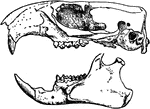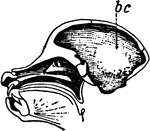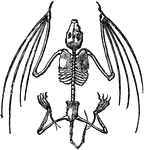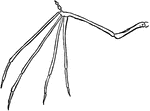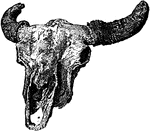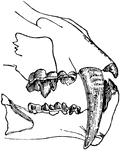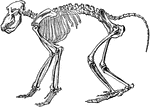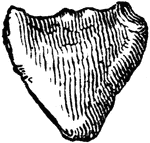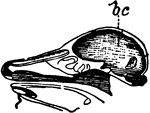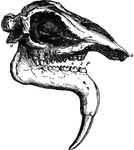The Mammal Anatomy: Skeleton ClipArt gallery provides 277 views of bones, teeth, and skeletal system of various mammals.
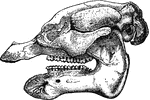
African Manatee
"Skull of African Manatee (Manatus senegatensis)." —The Encyclopedia Britannica, 1903
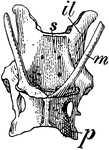
Pelvis of Spiny Anteater
An illustration of the pelvis of a spiny anteater. "m, marsupial bones; il, ilium; p, pubis; s, sacrum."…

Armadillo - Endoskeleton and Exoskeleton or Dermoskeleton
An illustration of a pichiciago, a small burrowing armadillo. The front half of the animal is covered…

Artiodactyles
"Bones of fore foot of existing Artiodactyle. Pig (Sus scrofa)." —The Encyclopedia Britannica,…
Artiodactyles
"Bones of fore foot of existing Artiodactyle. Red Deer (Cervus elaphus)." —The Encyclopedia Britannica,…
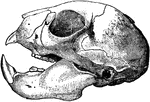
Aye-Aye Skull
"Skull of the Aye-aye (Chiromys madagascariensis)." —The Encyclopedia Britannica, 1910
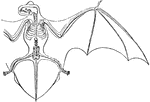
Skeleton and Wing Membranes of the Noctule Bat
The bat genus Nyctalus (Noctule bats) are Evening bats. They are distributed in the temperate and subtropical…

Bear Foot
"Palmar aspect of left fore foot of a black bear (Ursus americanus). scl, scapholunar; c, cuneiform;…

Leg of Bear
This illustration shows the plantigrade leg of a bear. Plantigrade means that the animal walks flat…

Scalpriform, Left Lower Incisor of a Beaver
Close-up illustration of scalpriform incisor of a beaver. It is "chisel-shaped; having the character…

Bennett's Kangaroo
"Skull and teeth of Bennett's Kangaroo (Macropus bennettii). i1, i2, i3, first second and third upper…

Bones of Coney's Foot
Homology of digits of odd toed mammals, showing gradual reduction in number and consolidation of bones.…

Bones of Elephant's Foot
Homology of digits of odd toed mammals, showing gradual reduction in number and consolidation of bones.…
Bones of Horse's Foot
Homology of digits of odd toed mammals, showing gradual reduction in number and consolidation of bones.…

Bones of Rhonoceros' Foot
Homology of digits of odd toed mammals, showing gradual reduction in number and consolidation of bones.…
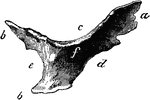
Cardiac Bone of an Ox
Right cardiac bone of an ox. Labels: a, anterior angle; b, posterior angles; c, superior border; d,…
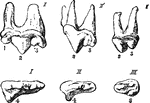
Carnivora
"Upper Sectorial Teeth of Carnivora. I, Felis; II, Canis; III, Ursus, 1, anterior, 2, middle, and 3,…

Carnivora
"Modifications of the Lower Sectorial Tooth in Carnivora. I, Felis; II, Cunis; III, Herpestes; IV, Lutra;…

Carnivorous Skeleton
The teeth of a carnivorous animal that lives on flesh alone. The front teeth are tearing ones, while…

Carpus of a Horse
Front aspect of the right carpus of a horse. Labels: 1, cuneiform; 2, lunar; 3, scaphoid; 4, trapezium;…

Deep Ligaments of the Carpus
Deep ligaments of the carpus- external view. Labels: a and b, deep portions of the external lateral…

Ligaments of the Carpus
Ligaments of the carpus-anterior aspect. Labels: a, internal lateral ligament; b, external lateral ligament;…

Ligaments of the Carpus
Ligaments of the carpus- postero-internal view. Label: a, b, deep portions of internal lateral ligament;…
Superficial Ligaments of the Carpus
Superficial ligaments of the carpus- posterior view. Labels: a, posterior annular ligament; b, posterior…

Domestic Cat Skull
"Skull of Cat (Felis catus), showing the following bones, viz. : na, nasal; pm, premaxillary; m, maxillary;…

Development of Cerebellum
Showing the development of the cerebellum. A, Transverse section through the forepart of the cerebellum…

Cow Skeleton
Skeleton of the cow. 1: Frontal bone of the head. 2: Upper jaw, superior maxillary. 3: Lower jaw, inferior…

Skeleton of a Cow
A skeleton of a cow shown to illustrate the internal skeleton which all vertebrates share. Labels: 1,…
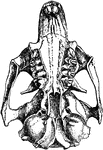
Cynomys Ludovicianus
"Under Side of Skull of Cynomys Ludovicianus." —The Encyclopedia Britannica, 1903

Skeleton of the Deer
"The bones in the extremities of this the fleetest of quadrupeds are inclined very obliquely towards…

Dendrohyrax Dorsalis
"Skull and Dentition of Dendrohyrax Dorsalis." —The Encyclopedia Britannica, 1903

Dinoceras Mirabile
The skull and upper jaw of an early rhinoceros-like mammal from the Cenozoic time.

Dog Skull
"Longitudinal and Vertical section of the skull of a dog, with mandible and hyoid arch. an, anterior…

Dog Skull
"Lower surface of dog's skull. o.c., Occipital condyle; B.O., basioccipital; T., tympanic bulla; m.c.,…
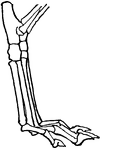
Leg of Dog
This illustration shows the leg of a dog. This leg is digitigrade. Animals with digitigrade legs walk…

Dolphin Teeth
"Upper and lower teeth of one side of the mouth of a dolphin, as an example of homodont type of dentition.…


